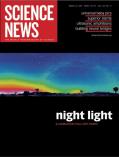| Ecological Consequences of Artificial Night Lighting News
|
This page is to share news and additional information pertaining the book Ecological Consequences of Artificial Night Lighting and its subject. Please send us your reactions to the book, news of new research, or anecdotes about the effects of artificial lighting on nature. Send any submittals to longcore@urbanwildlands.org with permission to post. June 18, 2009 -- Must read new reseach from Emma Stone and colleagues on how streetlights disrupt corridors of slow-flying bats (see the Guardian). This research confirms the impacts on connectivity from artificial lights described in Ecological Consequences of Artifical Night Lighting and especially Jens Rydell's chapter on bats. The article in Current Biology is linked here. March 2008 -- The Urban Wildlands Group's work is featured in an article in Chicago Wilderness Magazine about a groundbreaking new ordinance to protect the nighttime environment from excess light in Homer Glen, Illinois. March 17, 2008 -- Ben Harder of U.S. News and World Report published an article on light pollution that cites Ecological Consequences of Artificial Night Lighting. October 21, 2007 -- Science Director Travis Longcore spoke at the Morongo Basin Lighting Conference in late September. News account here. June 24, 2007 -- "The Nightsat mission concept" is a proposal for a new satellite to measure artificial night lighting, recently published in the International Journal of Remote Sensing. UWG Executive Officer Catherine Rich and Science Director Travis Longcore are co-authors. January 2007 -- Thorough new article in Zoogoer magazine titled "Dark, Interrupted." December 2006 -- A new study from B.J. Baker and J.M.L. Richardson in Canada shows that breeding behavior of male green tree frogs was affected by artificial light, in this instance provided by a hand-held flashlight. Male frogs exposed to the light moved more often, and made fewer and less complex advertisement calls than under ambient light. This has significant implications for impact analysis involving the introduction of intermittent light sources around wetlands (e.g., security lights, car headlights, etc.). June 1, 2006 -- Ecological Consequences of Artificial Night Ligthing is reviewed in the Electronic Green Journal. May 2006 -- Ecological Consequencs of Artificial Night Lighting is reviewed in the current issue of the Newsletter of the International Dark Sky Association. April 7, 2006 -- Ecological Consequences of Artificial Night Lighting is reviewed in Science. David Hill of the UK consultancy RPS is the reviewer. Pdf is here. |
|
|
home | people | links | contact
|
